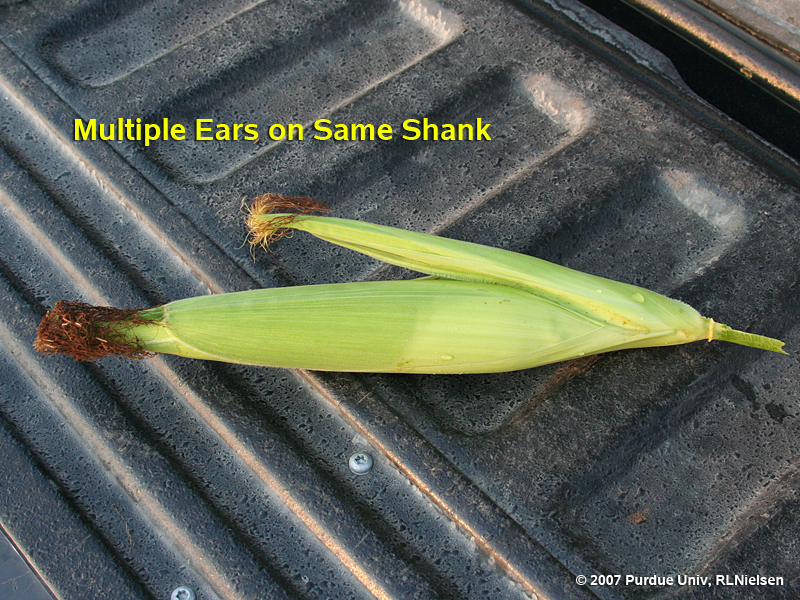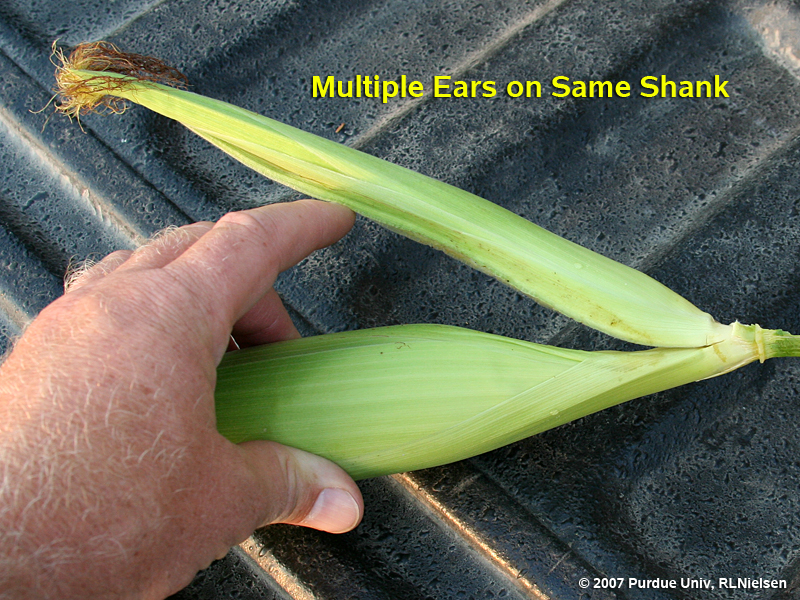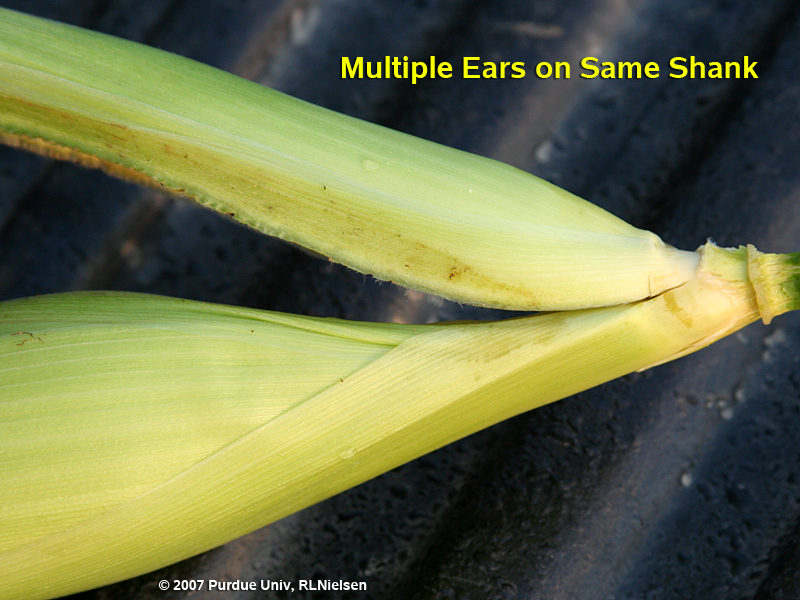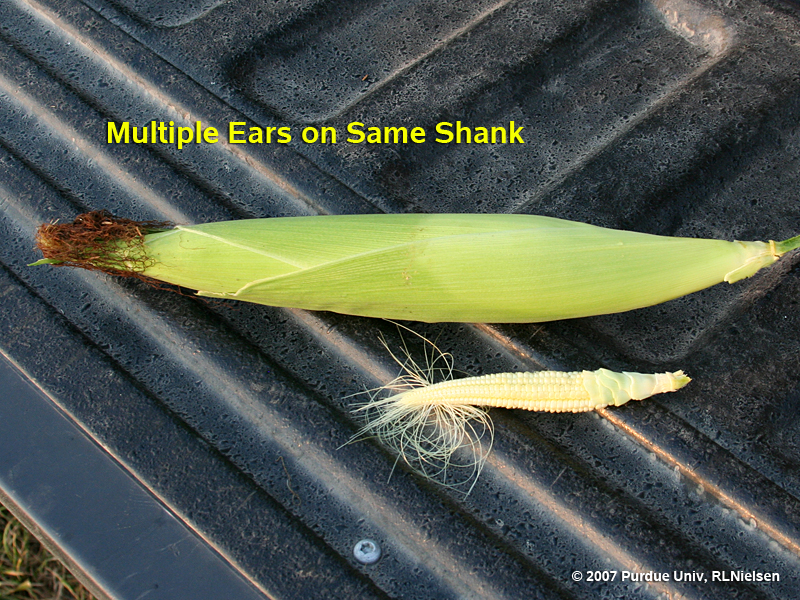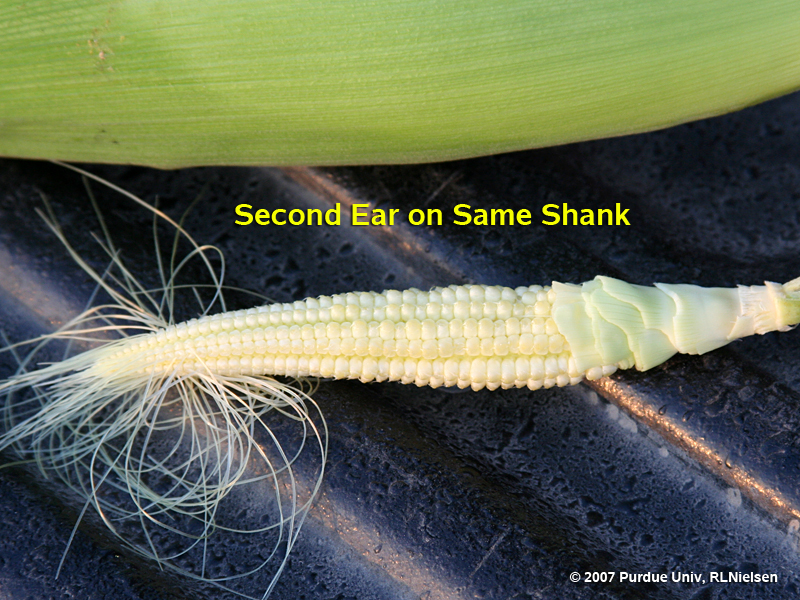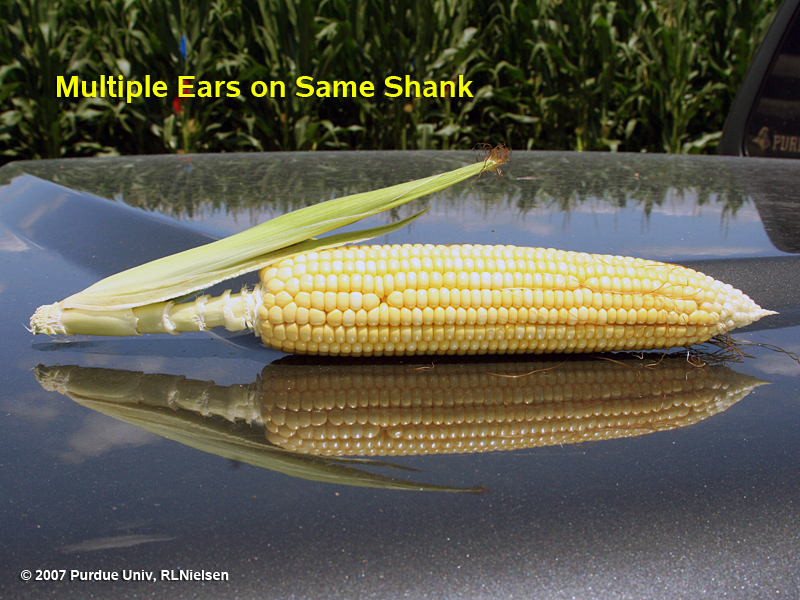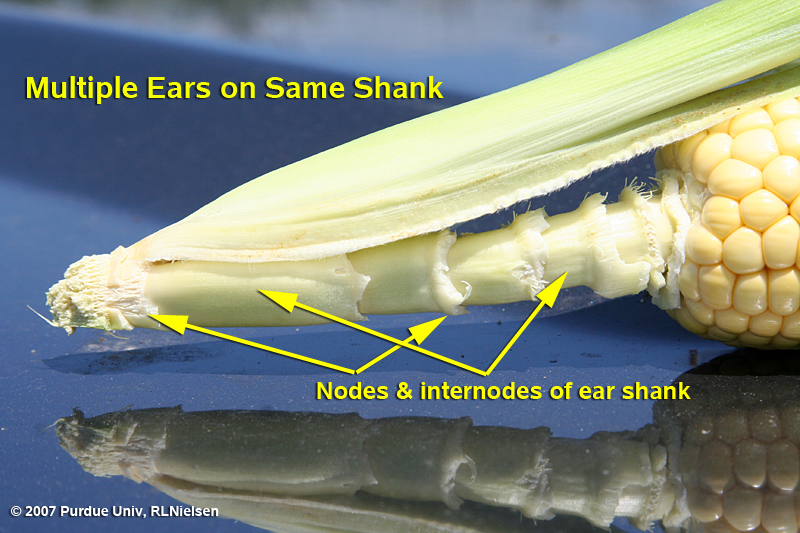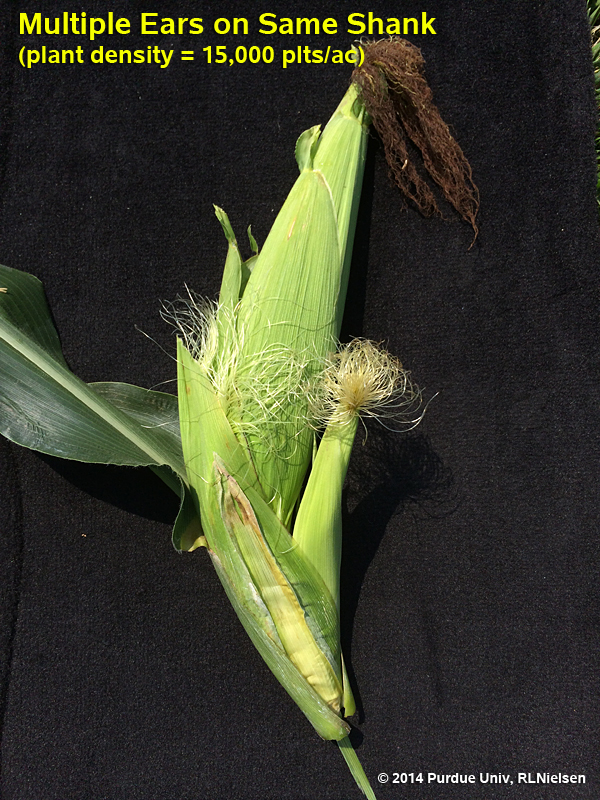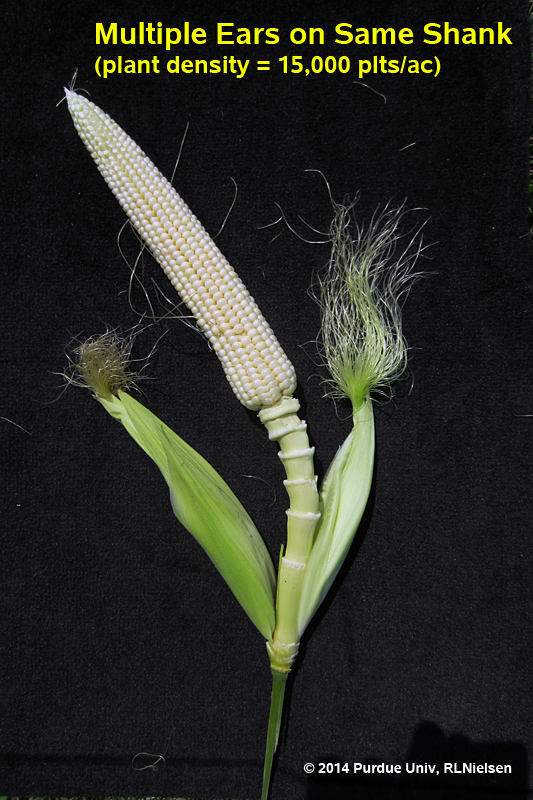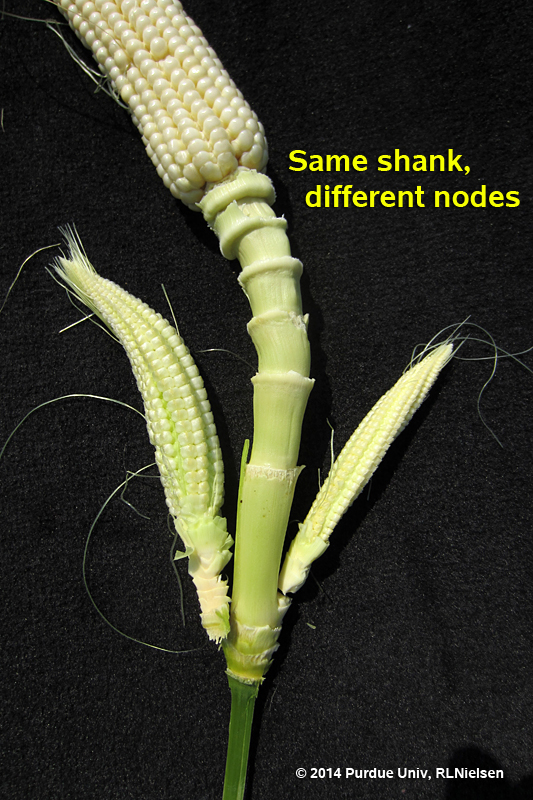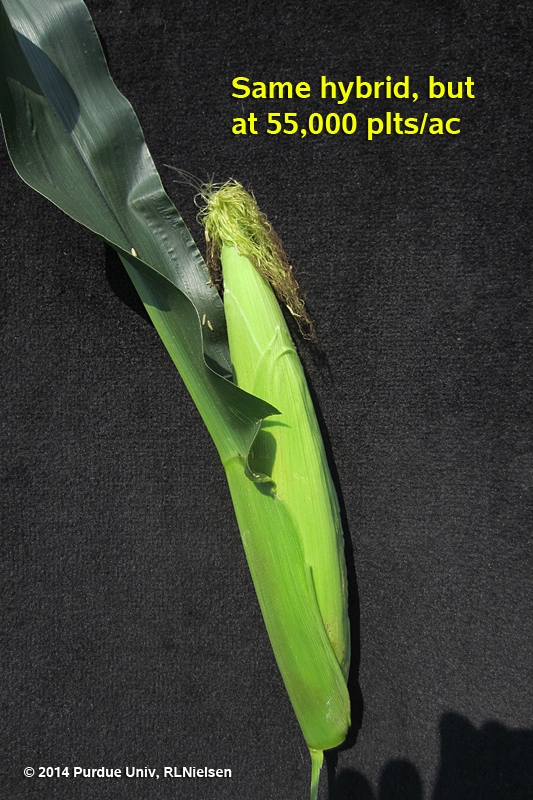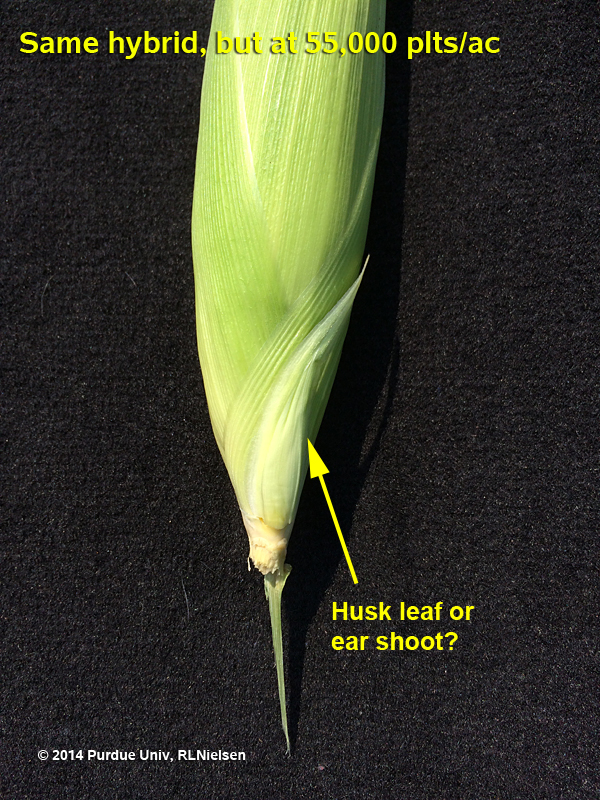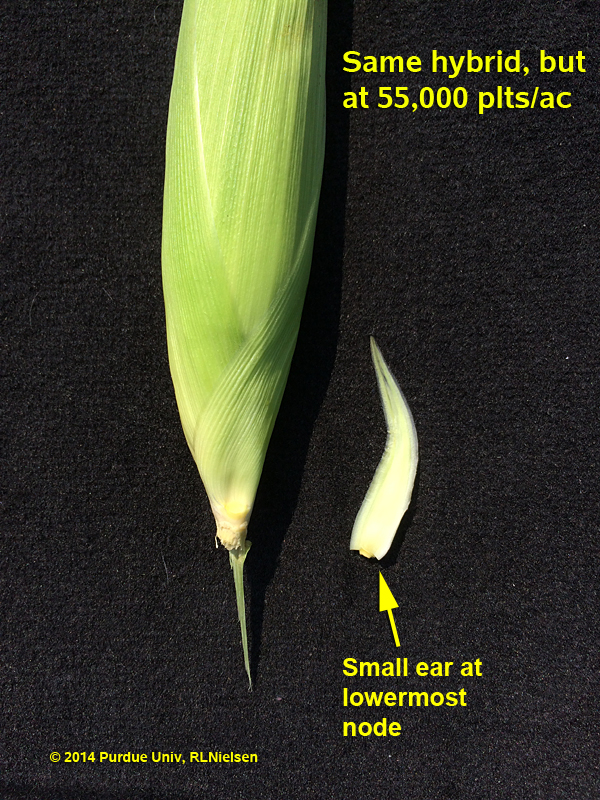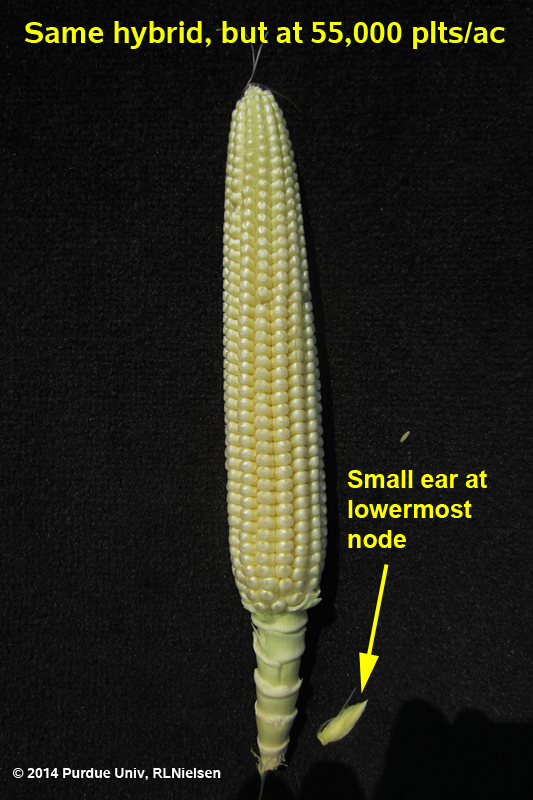July 2014
URL: http://www.kingcorn.org/news/timeless/MessyEars.html
Multiple Ears of Corn on the Same Shank
R.L. (Bob) Nielsen
Agronomy Dept., Purdue Univ.
West Lafayette, IN 47907-2054
Email address: rnielsen
at purdue.edu
![]() ost everyone knows that a corn plant initiates a lot of ears, one at every stalk node up to the one that becomes the harvestable one (Nielsen, 2007). Keen observers of the corn plant also recognize that multiple ears can also be found on the same ear shank. Bonnet (1966) briefly mentions this phenomenon and includes a photo in his classic publication that describes the development of inflorescences of major grass crop species. For what it is worth, I mentioned it myself fifteen years ago (Nielsen, 1999) and coined the term "MESS Syndrome" (Multiple Ears on Same Shank).
ost everyone knows that a corn plant initiates a lot of ears, one at every stalk node up to the one that becomes the harvestable one (Nielsen, 2007). Keen observers of the corn plant also recognize that multiple ears can also be found on the same ear shank. Bonnet (1966) briefly mentions this phenomenon and includes a photo in his classic publication that describes the development of inflorescences of major grass crop species. For what it is worth, I mentioned it myself fifteen years ago (Nielsen, 1999) and coined the term "MESS Syndrome" (Multiple Ears on Same Shank).
The fact that multiple ears sometimes develop from a single ear shank is not, in and of itself, physiologically unusual. Ear shank development essentially replicates the developmental pattern of the main stalk of the plant.
- The ear shank is comprised of nodes and internodes just like the main stalk (Fig. 7).
- Each node of an ear shank develops a leaf just like the main stalk, although we add the adjective "husk" to describe them.
- The ear shank terminates with a reproductive organ (the female ear), akin to the main stalk terminating with a reproductive organ (the male tassel).
- Secondary ear shoots can develop from individual nodes of the ear shank just like secondary ear shoots develop from individual nodes of the main stalk.
Normally, hormonal apical dominance exhibited by the primary or apical ear on an ear shank (or simple competition for photosynthates) suppresses the initiation or development of secondary ears at lower shank nodes. However, under certain conditions or with certain genetic backgrounds, one or more secondary ear shoots not only initiate successfully, but also continue to develop to the point that their presence is clearly noticeable. While the appearance of one or more additional ear shoots with silks emerging from lower husk leaves may not be attractive, I do not believe there is any real detriment to the plant by their existence as long as the primary ear is "normal".
Occasionally, the development of multiple ears on individual ear shanks "blossom" out of proportion (pun intended). Back in 2006, there was a rash of reports from cornfields throughout Indiana and Illinois of an odd multiple-eared phenomenon that I termed the “bouquet” effect (Nielsen, 2006). The characteristic of the “bouquet” effect was a dramatic development of multiple ear shoots from a single ear shank and, in the worst cases, none of the ears successfully pollinated or set kernels. The common factor in affected fields was some sort of damage to the development of the primary ear prior to or during silking that seemed to "set loose" the continued development of the secondary ears on the same ear shank.
A good friend of mine in the seed corn industry asked recently whether today's hybrids, being bred increasingly for higher plant densities, are more prone to this MESS syndrome when grown at lower plant densities than older hybrids that were more adapted to lower plant densities. I do not know the answer to that question, but I just happen to have one of these so-called "high plant density" hybrids in seeding rate demo plots at the Purdue Agronomy Farm and so went out to look at it the other day.
Sure enough, the plants in the demo plot planted at 15,000 seeds per acre in 15-inch rows were exhibiting the MESS Syndrome with one or two secondary ear shoots clearly visible from the primary ear shank (Fig's 8 - 10). It is also true that most of the plants at this low plant density were exhibiting more traditional secondary ears at stalk nodes below the primary ear. However, the MESS Syndrome was also evident in the demo plot planted to 55,000 seeds per acre in 15-inch rows, but at significantly less pronounced levels (Fig's 11 - 14).
By itself, this demo plot does not answer the question about hybrids bred for high density and their propensity for the MESS Syndrome relative to other hybrids. I suspect that some genetic backgrounds are simply more prone to this type of multiple ear development and that certain growing conditions encourage the MESS Syndrome with these hybrids..
Click on images to view larger versions.
Related References
Bonnet, O.T. 1966. Inflorescences of Maize, Wheat, Rye, Barley, and Oats: Their Initiation and Development. Univ. of Illinois, College of Ag., Agricultural Expt. Sta. Bulletin 721.
Nielsen, R.L. (Bob). 1999. What A MESS! (aka Multiple Ears on a Single Ear Shank). Corny News Network, Purdue Univ. http://www.kingcorn.org/news/articles.99/990823b.html. (URL accessed July 2014).
Nielsen, R.L. (Bob). 2006. A Problem with “Bouquets”. Corny News Network, Purdue Univ. http://www.kingcorn.org/news/articles.06/Bouquets-0912.html. (URL accessed July 2014).
Nielsen, R.L. (Bob). 2007. Ear Size Determination in Corn. Corny News Network, Purdue Univ. http://www.kingcorn.org/news/timeless/EarSize.html. (URL accessed July 2014).
Nielsen, R.L. (Bob). 2011. Kernel Set Scuttlebutt. Corny News Network, Purdue Univ. http://www.kingcorn.org/news/timeless/KernelSet.html. (URL accessed July 2014).

